The cheap and cheerful Boots Pacemaker CM viewfinder camera
The Boots Pacemaker CM camera is a version of the Regula Sprintic model C made for the Boots company at a time when Boots were a major supplier to amateur photographers.
My Boots Pacemaker CM camera
I was given this camera by John, a reader of my blog who had a number of cameras donated to him, and he didn’t need this particular model in his collection.
The unit is in very good condition for its age – almost unmarked in-fact, with every control working as it should. The light meter is still responsive to light, and there is still a battery fitted in the battery holder, although I haven’t measured it to see if it still holds charge.
Pictures of the Boots Pacemaker CM







Boots Pacemaker CM Description
This camera belongs to an age before the use of mobile phones to take photographs, when most people owned a camera. Since Boots was a popular supplier of photographic equipment and film for both enthusiastic photographers and for general purpose use, it isn’t surprising that they had several different models made for them by popular camera manufacturers.
This camera was made by King and was a version of their Regula Sprintic model C with the name changed to Pacemaker CM. Although Boots never commissioned high-end cameras to sell, this model was aimed squarely at the lower, entry level end of the market.
In design, the Pacemaker CM is a 35 mm viewfinder camera with an uncoupled light meter built into the top panel, a flash cube holder mounted directly above the lens and an interesting arrangement for setting the aperture and shutter speed.
The general construction of the camera is cheaply made with quite low grade, thin metal, and it’s quite obvious that the camera is made down to a price.
The camera is very easy to use because there are very few controls. Once loaded with film, the only settings are exposure and focus, and the camera has assistance to help with those.
For exposure, the light meter at the top of the camera is used to take a reading by pointing the camera towards the scene and then reading the meter needle position. The exposure read as a combination of both aperture and shutter speed, and the exposure settings round the lens barrel are arranged in the same groups.
So, at the bottom end of the scale it’s possible to select 1/30th and f/2.8 and at the top the camera offers 1/300th at f/16 with groups of other combinations in-between. This is a somewhat unique arrangement, and I can’t remember seeing it on any other camera.
For focus the camera is completely manual, with distances marked in both feet and meters, but there are also icons for Landscape, Group and Portraits which would help guess distances as well.
At the time the camera was made, the majority of people would not have used an electronic flash, but would have used a flash bulb if the scene was too dark.
This camera is equipped with a flash cube holder, which was a small plastic cube which has four flash bulbs fitted with reflectors behind each individual bulb.
When the film advance is moved, the cube holder rotates to move a new bulb into position and there is a switch on the back of the camera marked ‘B’ (which I take to mean bulb) which I assume is used to make the camera fire the flash when the shutter is pressed.
It’s a slightly odd arrangement, because if you were in a situation where a cube had some used bulbs and some unused, you could get to a situation where you need flash and an unused bulb isn’t in position. In that case, I guess the cube had to be manually turned (and I confirmed that the cube can be turned by hand either way – I guess the auto turning is for convenience when the camera is being used indoors).
On the bottom of the camera is a tripod bush and a small automatically reset frame counter.
Although the Pacemaker CM is a quite low grade camera, it’s still interesting from an historical point of view. My father’s first 35 mm camera was bought from Boots – a Beiretta model – and for all I know he could have considered the Pacemaker CM before settling on the Beiretta.
Boots Pacemaker CM Specifications
- Boots Pacemaker CM 35 mm viewfinder camera
- 45 mm f/2.8 Isco-gottingen lens
- Rectamat shutter with 1/30, 1/60, 1/125 & 1/300 shutter speeds
- Flash cube holder
- PX-23 5.6v battery for flash
- Non coupled light meter
- Light meter 12 to 400 ASA
- Frame counter on bottom of camera
- Tripod bush
- Bright frame lines in viewfinder
- Flash enable switch
- Threaded shutter release
- Serial No: 905429
Discover more from Everything Vintage
Subscribe to get the latest posts sent to your email.





